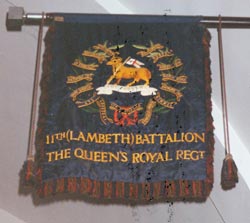The Colours of The Second or Queen’s Royal Regiment
Service Battalions
After the Great War, King George V instigated the award of a King’s Colour to every Service, Young Soldiers, Graduated and Garrison Battalion of the Regular Army, and also to Second and Third Line TF Battalions, TF Units serving as infantry, and battalions of overseas troops who had so served. The details were promulgated in Army Council Instruction 444, dated 21st July 1919, in which these Colours were referred to as “Silk Union Flags”, in order to obviate the necessity for consecration ceremonies. For The Queen’s, this applied to five of its Service Battalions: the 6th, 7th, 8th, 10th (Battersea), and 11th Service Battalions; to three of its Second Line TF battalions, the 2nd/4th, 2nd/22nd London, and the 2nd/24th London; and to one of its Third Line TF battalions, the 3rd/4th. The general pattern is as shown in figure 32.
 |
| Figure 32 |
Each Colour was to be a silk Union with in the centre a red roundel surmounted by a King’s Crown. On the roundel appeared the Regimental title – here “Royal West Surrey Regiment”. In the centre of the roundel appeared the title “The Queen’s”. In the first canton was placed the battalion numeral, a gold Roman figure. In the case of TF battalions this was an Arabic numeral above the Roman, ie 3 above IV for the 3rd/4th Battalion. This was the first time that battalion numerals had appeared in this position. No battle honours were displayed, since the award and subsequent laying up of these Colours preceded the award of the battle honours of the Great War.
The Colour of the 6th (Service) Battalion was presented at Masny, near Douai, Flanders, by HRH the Prince of Wales on 4th February 1919 and was laid up at Holy Trinity Church Guildford after the Battalion was disbanded in 1920. The remnants were later taken to the Regimental Museum.
The Colour of the 7th (Service) Battalion was presented at Villers Outreaux, France, by Lieutenant General Sir TLN Morland, GOC XIII Corps, on 16th January 1919 and was laid up at Holy Trinity. The remnants were later taken to the Regimental Museum.
The Colour of the 8th (Service) Battalion was presented by Lieutenant General Sir Arthur Holland, GOC I Corps, at Baisieux, near Lille, France, on 12th February 1919. On disbandment it was taken first to the Regimental Depot and later to Holy Trinity. The remnants were later returned to the Regimental Museum.
The Colour of the 10th (Battersea) Battalion was presented at Ehreshoven, Germany, on 11th February 1919 by General Sir Herbert Plumer, GOC-in-C Second Army. On disbandment in 1920 the Colour was sent to the Depot until 1933 when it was laid up in St Mary’s Church, Battersea. The remnants were later taken to the Regimental Museum.
 |
| A banner of the 11th Battalion was commissioned and presented to St George's Chapel, Ypres. (Click to enlarge) |
The Colour of the 11th (Lambeth) Service Battalion was presented at the Exerzierplatz, Cologne, on 11th February 1919 also by General Plumer. On disbandment in 1920 the Colour was handed over to the Mayor of Lambeth for display in Lambeth Town Hall. The remnants were later taken to the Regimental Museum.
The Colour of the 2nd/4th Battalion (TF) was presented at Engelskirchen, Germany, by General Plumer, on 7th April 1919. It was subsequently laid up in Croydon Town Hall and later transferred to Croydon Parish Church.
The Colour of the 2nd/22nd London was presented by HRH The Princess Mary on Horse Guards Parade, London, on 26th February 1921. It was then displayed in the Officers’ Mess of the 22nd London at Bermondsey, but its present whereabouts is not known.
The Colour of the 2nd/24th London was presented by General Holland at Pruwelz (Belgium) near Valenciennes, on 11th February 1919. Its present whereabouts is not known.
The Colour of the 3rd/4th Battalion (TF) was laid up in Croydon Parish Church; there is no record of its presentation.
Related
